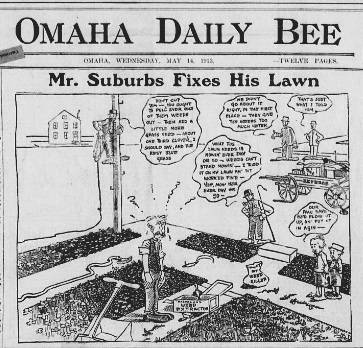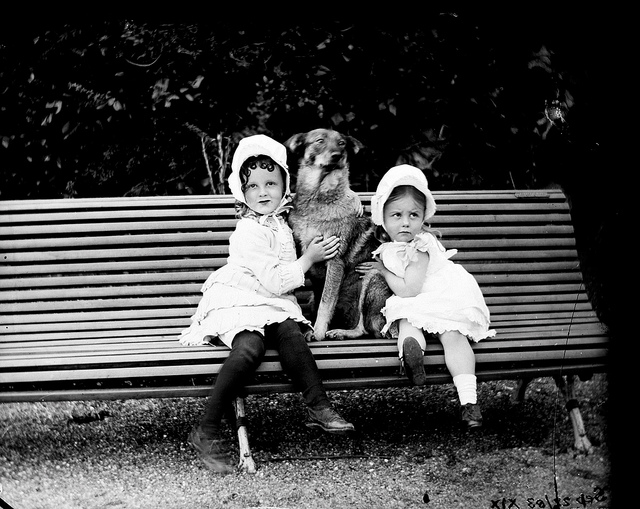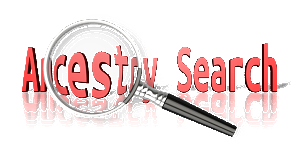by Lisa Cooke | May 14, 2013 | 01 What's New, Newspaper
Spring is in the air, as it was 100 years ago today. On May 14, 1913 the Omaha Daily Bee, the front page sported a comic depicting the eternal struggle of suburban life – fighting weeds in an effort to achieve the perfect lawn.

(Omaha daily bee., May 14, 1913, Weekly Market Review Edition, Image 1 Omaha daily bee. (Omaha [Neb.]) 187?-1922)
You can view the digitized paper featuring “Mr. Suburbs” at the Chronicling America website, along with digitized papers ranging from 1836 – 1922.
To learn more about using newspapers to climb your family tree grab a copy of my book How to Find Your Family History in Newspapers.
by Lisa Cooke | May 13, 2014 | 01 What's New, Family History Podcast, Immigration
Family History: Genealogy Made Easy Podcast
with Lisa Louise Cooke
Republished May 13, 2014

Listen to the Family History: Genealogy Made Easy podcast by Lisa Louise Cooke. It’s a great series for learning the research ropes and well as refreshing your skills.
https://lisalouisecooke.com/familyhistorypodcast/audio/fh31.mp3
Download the Show Notes for this Episode
Welcome to this step-by-step series for beginning genealogists—and more experienced ones who want to brush up or learn something new. I first ran this series in 2008-09. So many people have asked about it, I’m bringing it back in weekly segments.
Episode 31: Immigration and Naturalization Records for Family History, Part 3
Did you know that all those annotations and scribbles on passenger lists may hold important clues to your family history? In this episode, we continue our discussion with Stephen Danko about immigration and naturalization records. (If you missed them, they are Episodes 29 and 30.) Specifically,we’ll listen in on a presentation he gave on passenger list annotations and what the immigrant’s experience was like at Ellis Island.
So we’ve talked already about ship passenger arrival lists. Now let’s get out the magnifying glass, so to speak. We’ll look closely at the little notes on this records.
Annotations on passenger lists could have made upon departure, arrival or later when that immigrant applied for citizenship. One of the common misconceptions about passenger lists is that they were not filled out at Ellis Island, as many people believe. Rather they were completed at the port of departure. So notes could have been made at a variety of different times.
Here are three examples of annotations that were made upon a person’s arrival in the United States:
D=detained for inquiry
SI or DSI=Special Inquiry or Detained for Special Inquiry—this was really bad! (listen to the podcast to hear why)
USC=Was born in the U.S. or was a U.S. citizen
For a more thorough list of annotations on passenger records, read Stephen’s handout he graciously shared with us: A New Look at Immigrant Passenger Manifests. His companion blog posts (see Updates and Links below) show you real-life examples.
Here are some more great tips from that conversation:
- Check at the end of the manifest for pages called Record of Detained Alien Passengers, and Records of Release of Aliens Held for Special Inquiry.
- Our ancestors could have traveled back and forth from their homeland several times before they became citizens. Those passenger lists are just as valuable as their original immigration. If they hadn’t completed the naturalization process yet, then you may find an indication of that re-entry number or their citizenship status.
- As Stephen mentioned in a previous podcast, depending on the timeframe, your ancestor may have had to request a certificate of arrival when applying for citizenship. And if you haven’t found their naturalization records yet, and are lucky enough to find a certificate of arrival annotation on the passenger list, then you will have a really good chance for tracking them down.
- Certificates of arrival were required for anyone who applied for citizenship beginning in 1926 who had arrived after 1906. Annotations on the passenger list about the certificate of arrival (C/A) can lead you to where and when they applied for citizenship. A number like 1X-151953 indicates a request for a certificate of arrival was made after 1926 to help with the naturalization process. The first number “1” is the naturalization district, if there is an “X” it means the person didn’t have to pay for the Certificate of Arrival and the numbers after the dash are the certificate of arrival number or the application number. The date of the certificate of arrival may appear after this number sequence.
- Another code, VL, is the verification of landing, often seen for arrivals before 1906, before certificates of arrival were issued.
- Numbers like 432731 / 435765 = the passenger was a permanent resident of the U.S. and was returning home with a re-entry permit.
- If someone’s name was crossed out on the passenger list but the rest of the line was not, it probably means their name was amended. It was likely misspelled.
- Look through every page of the ship’s manifest for your ancestor’s voyage. You may find record of stops the ship made along the way, recording of friends or relatives, or even a second entry for your ancestor as Stephen mentioned in the case of changing class of ticket.
- The more recent the passenger list, the more information we’ll find and possibly the more annotations we may find. In my case my great-grandparents made the journey from Antwerp Belgium in 1910. In looking back over their passenger lists (they each have their own because they traveled three months apart) I found numbers and markings on their record that I hadn’t really paid much attention to. So when I heard Stephen’s talk I was very excited to figure out their meaning!
Listen to the podcast itself for more details on:
- Head taxes charged;
- Names entered at port of departure for people who may not have sailed;
- Why a person might appear twice on a passenger list;
- Notations that they were hospitalized upon arrival—or that they died there;
- The number of meals eaten at Ellis Island; and
- Grounds for exclusion for entry to the U.S.
Updates and Links
A New Look at Immigrant Passenger Manifests. This pdf by Stephen Danko provides a timeline history of the information requested on passenger lists. You’ll also find annotations made before and after arrival.
Stephen’s Blog: A New Look at Immigrant Passenger Manifests
Stephen’s Blog: More Annotations on Immigrant Passenger Manifests
One-Step Webpages by Stephen P. Morse (Ellis Island Search Tool)
by Lisa Cooke | Jan 13, 2015 | 01 What's New, Australian, British, Findmypast, Irish, Military, Records & databases
Did your Irish ancestors have a dog? Over 3.5 million Irish Dog Licence registers have been added to a collection already online at

“More Besties from the Clonbrock Estate.” Taken September 22, 1883. National Library of Ireland photograph, posted at Flickr Creative Commons National Library of Ireland on the Commons page. No known copyright restrictions.
FindMyPast. “Now containing over 6 million records, the Irish Dog Licences list not only the name, breed, colour and sex of your ancestor’s four legged friend, but also the owner’s address and the date the licence was issued, making them a valuable census substitute,” says a recent FMP press release.
Also new on the site are other notable collections, as described by FMP:
- Trade Union Membership registers (3.4 million+ records) with digitized images of original records books from 9 different unions. The documents include details about individual members such as payments made, benefits received, names of spouses, and a number of unions published profiles of their members or those who held offices. Many unions kept detailed records for when a member joined, paid their subscription, applied for funeral benefits or superannuation (retirement). These records allow you to follow your ancestor’s progress within the union and perhaps uncover previously unknown details of their working lives and careers. The documents can also include details about the trade unions themselves, such as directories of secretaries, meeting dates and times and items of trade union business. Many trade unions also included international branches from Ireland to Australia to Spain and Belgium.
- Indexes to over 28,000 articles in 2000+ PERSI-indexed periodicals. These include magazines, newsletters and journals, according to location, topic, surname, ethnicity and methodology. (Learn more about PERSI on FindMyPast in our blog post on the topic.)
- Peninsular War, British Army Officers 1808-1814 dataset, compiled by Captain Lionel S. Challis of the Queen’s Westminster Rifles shortly after WW1. Using Army lists, Gazettes, despatches, official records and regimental histories, Challis gathered information on more than 9,600 officers who fought for control of the Iberian Peninsula during the Napoleonic Wars and recorded them on index cards. Each record contains an image of the original handwritten index cards and a transcript.
- South Australia Births 1842-1928. Over 727,000 records and date back to when the compulsory registration of births first began in 1842. Sourced from an index transcribed by volunteers from the South Australian Genealogy and Heraldry Society Inc., each records consists of a transcript that usually includes the child’s full name, gender, date of birth, place of birth and registration number. The names of both parents will also be included and in some cases the mother’s maiden name will also be present. South Australia’s colonial origins are unique in Australia as a freely settled, planned British province.
- South Australia Marriages 1842-1937 contain over 457,000 records. Each record includes a transcript that can contain a variety of information such as the first and last names of the bride and groom, their ages, birth years, marital status, the date and place of their marriage as well as their fathers’ first and last names.
- South Australia Deaths 1842-1972 contain over 605,000 records and span 130 years of the state’s history. Each record consists of a transcript that usually lists the deceased’s full name, gender, status, birth year, date of death, place of death, residence, the name of the informant who notified authorities of their death and their relationship to the informant.
 Are you making the most of your online searches at FindMyPast and other genealogy websites? What about on Google? Learn more about search strategies that work in this blog post!
Are you making the most of your online searches at FindMyPast and other genealogy websites? What about on Google? Learn more about search strategies that work in this blog post!
by Lisa Cooke | Jun 17, 2013 | 01 What's New, Inspiration, Memory Lane, Organization, Photographs
 We genealogists often accumulate a lot of family “stuff:” original documents, old photographs and heirlooms. Though it’s wonderful to own them, it can be a serious challenge to keep them organized and documented.
We genealogists often accumulate a lot of family “stuff:” original documents, old photographs and heirlooms. Though it’s wonderful to own them, it can be a serious challenge to keep them organized and documented.
 Sunny’s 6 Tips for Organizing Your Genealogical Items
Sunny’s 6 Tips for Organizing Your Genealogical Items
1. Take stock of what you’ve got. Gather together all the original documents or photos, or take pictures of all your heirlooms, then review the entire collection at the same time.
2. Get rid of duplicates and stuff that doesn’t matter so much. You probably don’t really need all 10 of grandma’s quilts or those hundreds of scenic photographs from old family vacations. Rethink the 12-piece setting of china you’ll never use and grandpa’s tidy but prolific collection of nuts and bolts.
3. Carefully document and organize originals. Each kit includes supplies and instructions to help you safely identify each item. This is probably the most important step. We love our pictures, old letters and heirlooms because of the family connection. If that connection is lost, so is the value of the object.
4. Scan flat items and take digital pictures of dimensional ones. Keep these as “backups” in case the original is ever harmed. (The document and photo kits even come with Archival Gold CDs, which aren’t easy for genealogists to come by but perfect for long-term digital storage.) Use copies for reference and display, so you don’t expose your originals to everyday wear.
5. Store originals safely. The Heirloom Inventory kit includes suggestions for storing and displaying original objects. The document and photo kits include top-quality archival supplies and step-by-step illustrated instructions on how to store your stuff in them.
6. Share what you’ve got. Frame copies of your old photos and put them on the wall or a shelf. Keep copies of old documents handy to show relatives. Display your heirlooms. Use them all as conversation pieces whenever you get a chance. Tell stories about the people. Share memories that help other relatives understand why these items matter to you. That will help ensure that these items will live on in the family lore.
by Lisa Cooke | Sep 9, 2013 | 01 What's New, Inspiration, Organization

This morning I looked out my window and could see a huge plume of smoke. Across the valley a wild fire is raging that began yesterday afternoon. The hot and very dry conditions have fueled the flames, and homes are starting to be evacuated. It’s a grim reminder that disasters do happen and no one is immune.
It is National Preparedness Month in the United States, and for genealogists, that means disaster planning for our home archives and family history files. We don’t like to think about the unthinkable: losing our original photos, documents and years’ worth of research in a fire, flood, hurricane or other disaster. But it’s happened in places as high-and-mighty as federal archives here in the USA: it can certainly happen in our homes. Even a leaky roof, downed tree, bug infestation, basement mildew issue, theft or other “minor” disaster can mean total annihilation of our family archives if it’s in the wrong place at the wrong time.
As I watch the fire and monitor it’s progress on Twitter, I’m thankful that I can rest easy that my precious family history is protected in a number of ways. This month, I’ll share four steps to help you secure the future of your family past, one step for each of the next four weeks. This gives you time to follow through on each piece of advice before you get to the next step. This week’s step:
ASSESS YOUR GENEALOGY ASSETS. What needs protection?
Your top priority, as a genealogist, will likely be original photos, documents, artwork and one-of-a-kind family artifacts like a family Bible. In other words, things that can’t be replaced.
Next, think about things you’d rather not have to replace: records you’ve ordered from repositories; several years’ worth of genealogy notes and files; computerized family trees. Make yourself a list, so in the weeks to follow you can carry out an emergency plan for each item (starting with high-priority items) as your time and budget permit. Next week’s topic: DUPLICATE THE PAST.







